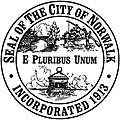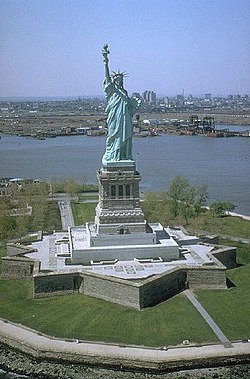Norwalk, Connecticut | |
|---|---|
| Etymology: Mohegan-Pequot language | |
| Nickname: Oyster Town | |
| Motto: Latin: E Pluribus Unum | |
| Coordinates: 41°05′38″N73°25′11″W / 41.09389°N 73.41972°W | |
| Country | |
| U.S. state | |
| County | Fairfield |
| Region | Western CT |
| Settled | February 26, 1640 |
| Incorporated | September 11, 1651 |
| Consolidated | June 6, 1913 |
| Founded by | Roger Ludlow and Daniel Patrick [1] |
| Government | |
| • Type | Weak mayor–council |
| • Mayor | Harry Rilling (D) |
| Area | |
• Total | 36.37 sq mi (94.20 km2) |
| • Land | 22.89 sq mi (59.28 km2) |
| • Water | 13.49 sq mi (34.93 km2) |
| Elevation | 43 ft (13 m) |
| Population | |
• Total | 91,184 |
| 93,567 | |
| • Density | 3,983.90/sq mi (1,538.192/km2) |
| Time zone | UTC−5 (Eastern Standard Time (EST)) |
| • Summer (DST) | UTC−4 (Eastern Daylight Time (EDT)) |
| ZIP Codes | 06850–06860 |
| Area codes | 203/475 |
| FIPS code | 09-55990 |
| GNIS feature ID | 0209405 |
| Major highways | |
| Commuter rail | |
| Website | www |
Norwalk is a city in Fairfield County, Connecticut, United States. The city, part of the New York Metropolitan Area, is the sixth-most populous city in Connecticut as of the 2020 census, with a population of 91,184. [5]
Contents
- History
- Geography
- Neighborhoods
- Climate
- Topography
- Demographics
- 2020 census
- 2010 census
- Economy
- Arts and culture
- Attractions
- Notable sites on the National Register of Historic Places
- Government
- United States Congress
- Connecticut General Assembly
- Politics
- Districts
- Representatives
- Education
- Sports
- Media
- Transportation
- Highways
- Buses
- Railroad
- Airports
- Infrastructure
- Utilities
- Emergency services
- In popular culture
- Films
- Television
- Notable people
- Sister cities
- References
- External links
Norwalk is on the northern shore of Long Island Sound and was first settled in 1649.




















